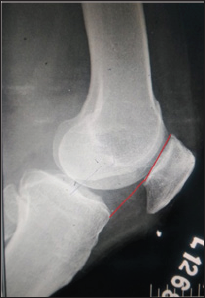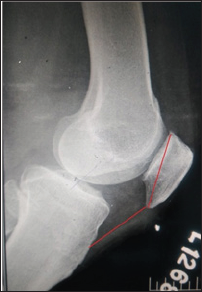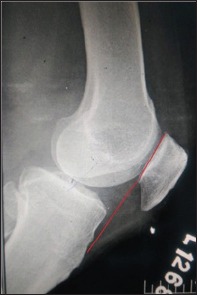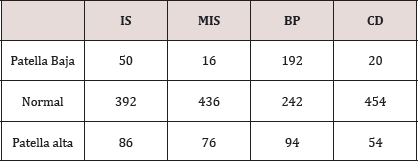Lupine Publishers | Journal of Orthopaedics
Abstract
Methods: Lateral radiographs of 528 knees with anterior knee pain were performed. Patellar heights were measured to calculate the Insall-Salvati (IS), Insall-Salvati Modified (MIS), Blackburne-Peel (BP), Caton Deschamps (CD) ratios.
Results: The overall mean LT/LP ratio was 1.03 (SD 0.37) with incidence of 16.2% (86/528) for patella alta with Insall-Salvati. Mean MIS was found to be 1.68 (SD 0.018) and incidence of patella alta as per MIS ratio was 14.3% (76/528). Blackburne-Peel and Caton-Deschamps ratios revealed mean ratios of 0.88 (SD 0.15) and .99 (SD 0.16) and the incidence of patella alta 17.8% with BP ratio and 10.2% with CD ratio respectively.
Conclusion: Incidence of patella alta was found to be 17.8% with BP ratio, 16.2% with IS ratio, 14.3% with MIS ratio and 10.2% with CD ratio. The BP and IS ratio were the most sensitive with MIS ratio being the more specific one and CD ratio the least sensitive.
Introduction
The study objective was to analyse the commonest methods for measuring the patellar height in patients with anterior knee pain and the aim of this study was to report the incidence of patella alta and patella baja and investigate whether the patellar height ratios have significant variations in adult indian population in which sitting on the ground, kneeling, and squatting is common.
Materials and methods
Figure 2: CD.


The measurements were made with the digital imaging software (Radiant
diacom viewer) by a single experienced physician. The patella length
was measured from the superior articular pole to the inferior non
articular pole (Figure 1). The distance from the origin of the patellar
tendon at the inferior pole of patella to its insertion on the tibial
tubercle was taken as the patellar tendon length. The Insall-Salvati
index is calculated as ratio of LT/LP, where LT is the length of the
patellar tendon and LP is the patella length (Figure 1). The
Blackburne-Peel index (Figure 2) is calculated as PP/PG where PP is the
perpendicular height of the distal part of the joint surface of the
patella to a line projected anteriorly to the surface of the tibial
plateau and PG is the length of the articular surface of patella. The
ratio PTG/PG, in which PTG is the distance from the lower edge of the
articular surface of the patella to the anterosuperior angle of the
tibia, and PG is the length of the articular surface of the patella is
calculated as Caton-Deschamps index (Figure 3). The Modified
Insall-Salvati index consists of the ratio PT/PG, wherein PT is the
distance from the lower edge of the joint surface of the patella to the
insertion of the posterior or deep surface of the patellar tendon in the
tibial tubercle, and PG is the length of the joint surface of the
patella (Figure 4).
Discussion
The position of the patella has an important role on patellofemoral function. Abnormalities in patella position have thus been associated with anterior knee pain and many extensor mechanism disorders. While many techniques have been developed to measure patellar position such as the Blacburne's ratio, the Insall Salvati ratio still remains one of the most popular, largely because it is easy to use and remember [7,8] .Despite its popularity, recent studies have suggested that the current normal ranges should be extended, as the ratios may not be applied to ethnicities outside western regions [11,12].
The Insall-Salvati (IS) method uses the length of the patellar ligament in relation to the length of the patella6. The patellar morphology and morphological differences in the anterior tuberosity of the tibia (ATT) directly affect the measurements made using this method. Grelsamer and Meadows [7] developed the modified Insall-Salvati (ISM) method based on the length of the joint surface. Difficulty in identifying this parameter is considered to be the main measurement bias. The Modified Insall -Salvati ratio has its advantages over the IS ratio that it can efficiently find out the patella alta in patients with small patellar articular surface which is not taken into account in IS ratio (Figure 5). Digital radiography seems not to present greater details for this anatomical reference. The Blackburne-Peel (BP) method exchanges the reference point of the ATT for the joint surface of the tibial plateau, while keeping the joint surface of the patella. Although Berg et al. [13] found that this was the most accurate and reproducible method in conjunction with the IS index, and Seil et al. [13] ranked it as the second most reproducible method in conjunction with the IS index, we did not obtain similar results in our analysis, such that it was only better than the ISM index. Lack of definition of the reference line of the tibial plateau, such as which condyle to use as the reference, or whether this line runs parallel to the joint surface or perpendicular to the long axis of the tibia, contributes towards lower concordance with this method. The method of Caton et al. [2], which uses the joint surface of the patella and the angle of the tibial plateau as references, also presents difficulty regarding identification of the joint surface, as well as presenting a certain amount of variability in defining the angle of the tibial plateau. Despite these factors, this method was the one that showed greatest concordance in the study by Seil et al. [13].
The mean IS ratio was 1.02(SD 0.37) with the incidence of patella alta being 16.2%. The incidence of patella alta calculated by height ratios was found to be lesser than that of the published literature. Out of the ratios analysed, it ws found out that the IS ratio and BP ratio had the highest sensitivity for patella alta wherein the CD ratio had the lowest sensitivity. The difficulty in analysing the anatomy of the proximal tibia may be attributed to the decreased sensitivity of CD ratio. MIS ratio is helpful in situations where in the patellar articular length is decreased compared to that of the length of patella (Figure 5). The study had the most sensitive ratio as BP ratio followed with IS ratio, MIS ratio and lastly CD ratio which is comparable to the study by Seil et al. [13]. It was interesting to note that, patella baja were present in a proportion of patients with knee pain signifying the requirement of understanding the knee biomechanics and further evaluation of the patellofemoral joint for the articular cartilage. Patella alta was found to have a incidence of 16.2% as per Insall- Salvati ratio and needs to be kept in mind in paients with anterior knee pain.
For more Lupine
Publishers Open Access
Journals Please visit our website:
For more Open Access Orthopedics and Sports medicine articles Please Click Here:
To Know More About Open Access Publishers Please Click on Lupine
Publishers
Follow on Linkedin : https://www.linkedin.com/company/lupinepublishers
Follow on Twitter : https://twitter.com/lupine_online








No comments:
Post a Comment
Note: only a member of this blog may post a comment.